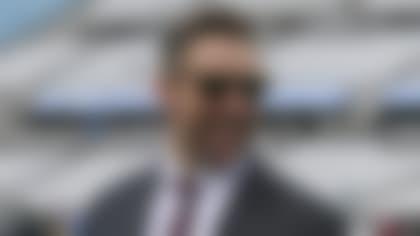It is only fitting that in the same year Bruce Smith receives induction into the Pro Football Hall of Fame, the Buffalo Bills are depending on his contemporaries to engineer a postseason run.
Whereas it would appear that the pressure of the Bills' playoff aspirations rests with an offense that has been completely overhauled during the offseason, it is the success of the defense -- particularly the defensive line -- that ultimately will determine the team's postseason fate in 2009.
Discuss: Impact of T.O.
As part of NFL Network's
32 teams in 32 days series, Jamie Dukes and Solomon Wilcots examine the impact Terrell Owens will have on the Bills' offense next season. More ...
The Bills' defense has shown significant improvement under the direction of coordinator Perry Fewell. The unit ascended to 14th in the NFL in total defense last season after surrendering the second-most yards in 2007. In addition, the Bills yielded just 14 passing touchdowns and held opponents to 21.4 points per game last season.
Although those numbers reflect the development of a defense burgeoning with young talent, the Bills still have work to do to field a top-10 unit in 2009. The team's pass rush netted just 24 sacks a season ago, and the lack of consistent pressure greatly contributed to its inability to create turnovers. The Bills tallied just 22 takeaways, including the fifth-fewest interceptions (10) in the league. Moreover, the defense ranked 22nd in rush defense by allowing 121.6 yards per game on the ground.
Given the improvement needed by the defense, it is no wonder that the defensive line finds itself in the crosshairs heading into training camp.
In Fewell's 4-3 scheme, which features a number of elements often found in "Tampa 2" defenses, the pillar is the defensive line. The system is dependent on the front four controlling the line of scrimmage, which allows the rest of the defense to function effectively against the run or pass. The premise is to always keep an extra defender in coverage while defending the run with a seven-and-a-half man front (the corners often are rolled up in two-deep coverage, which allows them to assist on outside runs). Though this deviates from the loaded boxes or eight-man looks that most teams use to defend the run, this approach can be effective if the defensive line is able to dominate at the point of attack. With the success of the defense predicated on the performance of the frontline, the onus is on the Bills' defensive line to come up big.
The Bills seemingly have the necessary personnel to execute the scheme. Marcus Stroud gives the team the hulking "three-technique" to control the interior of the line. The three-time Pro Bowler aligns over the guard in a shaded position and occupies two blockers because of his positioning. Stroud, who was acquired in a trade from the Jacksonville Jaguars in 2008, excels at defeating double teams while providing consistent penetration upfront. He routinely plays in the opponent's backfield, and his presence inside allows Kavika Mitchell and Paul Posluszny to run unobstructed to the ball carrier.
In addition, Stroud's ability to create a push inside creates one-on-one rush situations for the Bills' edge rushers. Although the eight-year pro recorded just 2.5 sacks last season, he commands double teams on passing downs and is capable of single-handedly dominating the middle when facing single blocks.
Whereas Stroud garners the headlines as the Bills' most dominant interior defender, Kyle Williams serves as a nice complement at the opposite tackle. The three-year pro is a high-motor player with good strength and power. His relentless energy and skillful hand usage allows him to win his fair share of battles, and he netted two sacks in 2008 as a result. Though he has toiled in relative anonymity during his first three seasons, a breakout performance by Williams will be critical to the defense's performance.
Aaron Schobel returns to the lineup to function as the designated pass rusher off the edge. The eight-year pro missed most of last season because of an injury, and the loss of the two-time Pro Bowler crippled the Bills' pass rush. Schobel has tallied double-digit sacks in three of his eight seasons, and his 53 sacks since 2003 rank as the fifth-highest total during that span. Without that presence on the outside, the Bills' pass rush was virtually non-existent and the rest of the defense suffered as a consequence.
To prevent such a disaster from happening in 2009, the Bills selected Aaron Maybin in the first round of the draft to bolster their pass rush. The former Penn State star tallied 12 sacks during his final season in Happy Valley and gives the Bills an explosive player on the edge. As a freakish athlete with an exceptional burst, Maybin has the ability to generate pressure with speed and quickness.
Though he enters the league without a full complement of moves to throw at offensive tackles, Maybin's athleticism alone is enough to cause problems for quarterbacks. With Maybin slated to line up at left defensive end, he could tally big sack numbers as a rookie while working against the opposition's weaker tackle (most teams with right-handed quarterbacks place their best tackle on the left side to protect the quarterback's blindside, so right tackles typically aren't as quick or polished in pass protection).
While Maybin upgrades the Bills' pass rush, his lack of bulk makes him a liability against the run, and the team might play him as part of a platoon at the position. Chris Kelsay and Ryan Denney also are likely to see time on early downs. While the duo was disappointing as a starting tandem a year ago, they could benefit from playing as spot players.
Kelsay, a six-year veteran with 72 career starts, has struggled to generate consistent pressure off the edge the past two seasons, and he might be better suited to playing as a run-down defender at this point in his career. His two sacks last season represent a career low and continue the downward trend of sack production since his career high of 5.5 in 2006. Freed from the expectations of producing high sack totals, Kelsay might re-emerge as the hard-nosed competitor that the Bills need in the run game.
Denney, who filled in at right defensive end during Schobel's absence, gives the team a wily veteran capable of contributing as part of a rotation. Though the seven-year pro amassed four sacks last season, he is not noted for his rush ability and will make better contributions as an edge run defender. His presence in the rotation will allow the Bills to rest Schobel and keep their best pass rusher fresh for key moments late in games.
With a vastly improved pass rush, the Bills' secondary is sure to benefit from the errant throws that come from a harried quarterback. Tips and overthrows typically result in interceptions, and thpse game-changing plays would give the ball back to a potentially explosive offense. Moreover, a fierce pass rush will protect a young secondary that is poised to start a rookie (Jairus Byrd), a second-year pro (Leodis McKelvin) and two young veterans (Donte Whitner and Terrence McGee).
A rebuilt offense has Bills fans envisioning a playoff run, but a remodeled defensive line will decide if the dream comes true.





